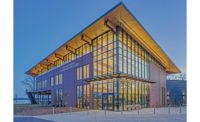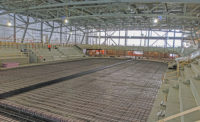Cabrini University Athletic and Recreation Pavilion
Radnor, Pa.
Best Project
Owner: Cabrini University
Lead Design Firm: WRT LLC
General Contractor: Warfel Construction Co.
Civil Engineer: SITE Engineering Concepts LLC
Structural Engineer: CVM Professional
MEP Engineer: H.F. Lenz Co.
Subcontractors: Paramount Contracting Inc. (Framing, Drywall, Ceilings, Stucco); Swartley Bros. Engineers Inc. (Electric); H.L. Wiker Inc. (Sitework, Exterior Concrete Framework); Jones Construction Services (Stone)
A tight 15-month schedule for converting Cabrini University’s outdated and cramped athletics building into a top-flight sports facility and events venue required the team to coordinate activities to keep parts of the building open and fully functioning during construction. The team did renovation work in small areas so other sections of the facility could be used and took extra care to ensure the site was clean and safe during basketball games.
The project includes a 28,000-sq-ft expansion that features a two-story atrium with a full-length glass curtain wall, filling the interior with natural light. Another 20,000 sq ft of interior renovations were completed in the existing athletics center. Overall, the finished project includes fitness and studio rooms, locker rooms for intercollegiate teams, weight-training rooms and meeting areas.
The L-shaped addition that wraps around the old building relied on critical tie-in elements. Virtual models showing MEP and structural tie-ins helped craft workers plan work appropriately and reduced change orders by identifying more than 500 steel beam, ductwork and piping conflicts running to the existing building.
The building’s new entrance features a two-story wall with stones that were hand-shaped and fitted as they were set to match similar walls around the campus.
Support columns were threaded through the building’s original footings to install a new floor above the existing first-floor space. Beams were carted through the front door, one-by-one, and hoisted into place to create two additional second-floor classrooms in space that used to contain squash courts. Some of the space previously used for the two-story courts was converted into a conference space.
The occupied renovation called for a safety program that went beyond Occupational Safety and Health Administration standards. The team conducted mock OSHA inspections once a month. The project had a perfect OSHA recordable incident rate and lost-time accident rate during 224,900 worker-hours. “When you think about building something on a college campus that is completely functional and operating all around you,” one judge says, “I liked the safety aspect.”
Due to the sensitive environment with students, workers were required to wear hardhat stickers to show clean FBI and state police checks that the judge says “in this day and age is unfortunately ... necessary.”
The team also was required to preserve a wooded area that surrounded the site on all sides but one. Work was completed from back to front to avoid using equipment near the trees at the rear of the building. “We essentially worked our way out of the front of the building,” the submission says. “With no room for laydown, and the parking lot at capacity with daily commuter students, we arranged for offsite parking for subcontractors and suppliers and shuttled workers to the site.”
Just-in-time deliveries also helped minimize parking lot congestion. The team finished the project before the fall 2016 semester so Cabrini could host previously booked events and highlight the facility in marketing and recruiting efforts.
Related Article: Region’s Best Work Meets Big Challenges






